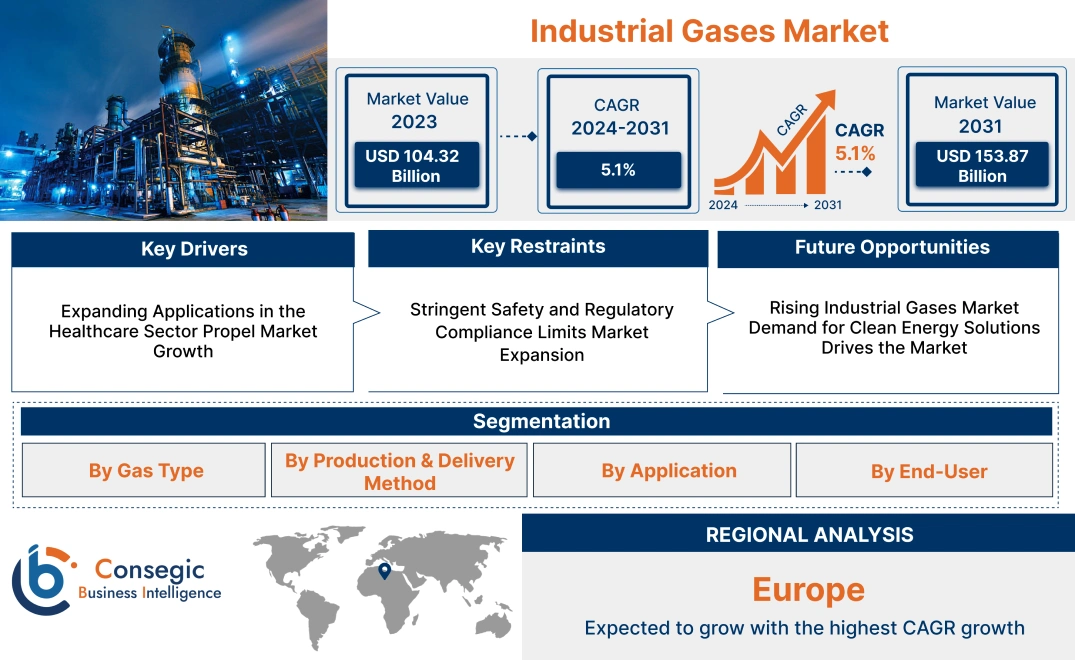- Summary
- Table Of Content
- Methodology
Industrial Gases Market Size:
Industrial Gases Market size is estimated to reach over USD 153.87 Billion by 2031 from a value of USD 104.32 Billion in 2023, growing at a CAGR of 5.1% from 2024 to 2031.
Industrial Gases Market Scope & Overview:
The industrial gases market involves the production and supply of gases used in a wide range of industrial applications. Common gases include oxygen, nitrogen, carbon dioxide, argon, hydrogen, and helium, each having unique chemical properties tailored for specific uses. These gases are critical in manufacturing processes, welding and cutting, food and beverage preservation, medical treatments, and electronics fabrication. Key features of these gases include their purity, consistency, and suitability for high-appeal applications. The primary benefits include improved process efficiency, enhanced product quality, and adherence to safety and environmental standards. Applications span industries like chemicals, healthcare, food and beverages, metallurgy, and electronics. The end-use industries rely on these gases for applications like metal fabrication, chemical synthesis, food packaging, and respiratory therapies, driven by growing industrialization, technological advancements, and increasing trends for high-performance manufacturing processes.
Industrial Gases Market Dynamics - (DRO) :
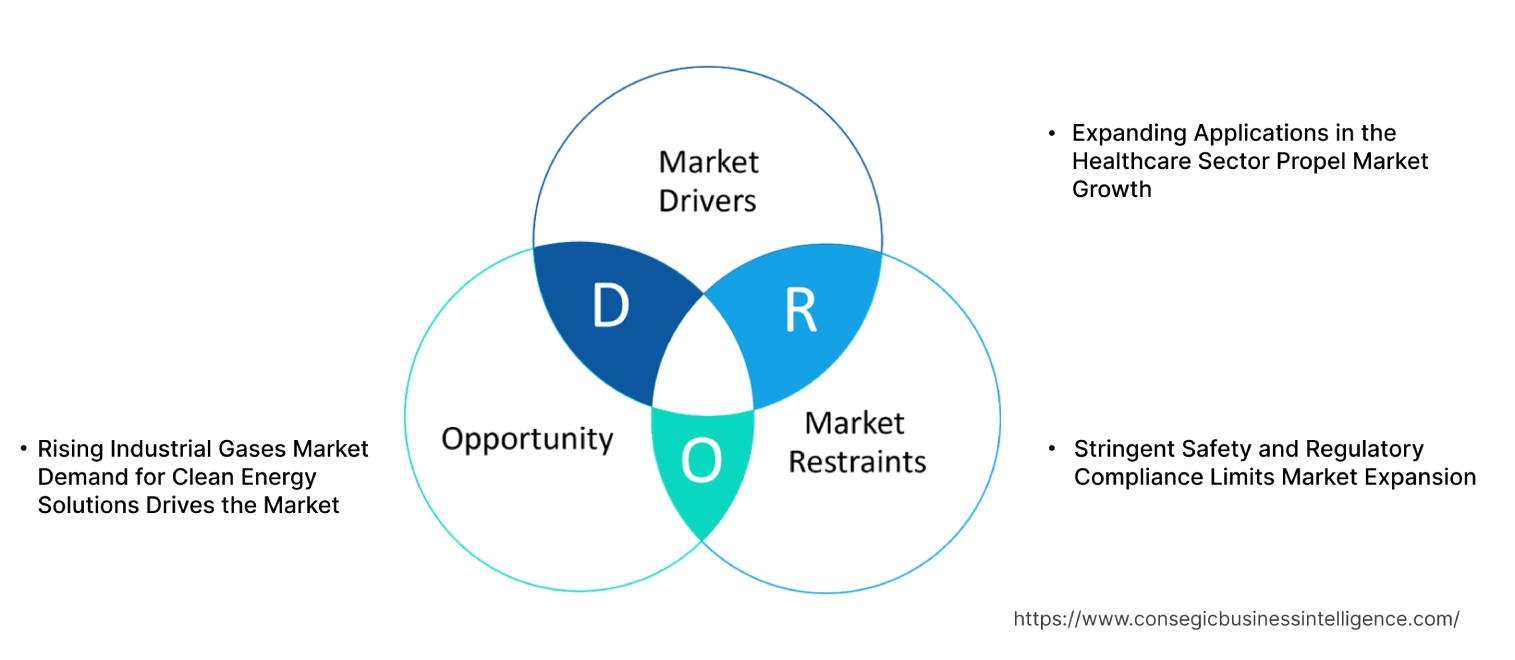
Key Drivers:
Expanding Applications in the Healthcare Sector Propel Market Growth
The growing trend for these gases in the healthcare sector is a significant driver for the market. Gases such as oxygen, nitrogen, and nitrous oxide are essential in various medical applications, including respiratory therapy, anesthesia, and cryopreservation. The increasing prevalence of chronic respiratory diseases, such as COPD and asthma, is driving the need for medical-grade oxygen in hospitals and home healthcare settings. Furthermore, the rising number of surgeries and emergency procedures is boosting the use of nitrous oxide for anesthesia. As healthcare providers prioritize patient safety and efficient treatment, the trends for high-purity gases continue to grow, driving industrial gases market expansion.
Key Restraints :
Stringent Safety and Regulatory Compliance Limits Market Expansion
The industrial gases market is significantly restrained by stringent safety and regulatory requirements. The gases, such as oxygen, hydrogen, and carbon dioxide, are classified as hazardous substances, necessitating strict adherence to safety standards during production, storage, and transportation. Regulatory bodies like the Occupational Safety and Health Administration (OSHA) and the European Chemicals Agency (ECHA) impose comprehensive guidelines to mitigate risks associated with handling these gases. Compliance with these regulations requires substantial investments in safety infrastructure, monitoring systems, and specialized training for personnel, increasing operational costs for manufacturers. These regulatory hurdles can slow down the adoption of these gases, particularly in smaller industries with limited resources, thus hindering overall industrial gases market growth.
Future Opportunities :
Rising Industrial Gases Market Demand for Clean Energy Solutions Drives the Market
The growing focus on clean energy and sustainable industrial practices presents a significant industrial gases market opportunity. The gases like hydrogen and carbon dioxide are increasingly being used in renewable energy projects, including hydrogen fuel cells and carbon capture and storage (CCS) technologies. The push for decarbonization in industries such as automotive, energy, and manufacturing is driving the adoption of hydrogen as a clean fuel alternative. Additionally, the use of carbon dioxide in enhanced oil recovery (EOR) and its potential for carbon sequestration support the market's prospects. As industries seek to reduce their carbon footprint, the advancement of innovative industrial gas applications is expected to rise, creating new avenues for industrial gases market expansion.
Industrial Gases Market Segmental Analysis :
By Gas Type:
Based on gas type, the market is segmented into oxygen, nitrogen, hydrogen, carbon dioxide, argon, helium, acetylene, and others.
The nitrogen segment accounted for the largest revenue in industrial gases market share in 2023.
- Nitrogen is extensively used across various industries due to its inert properties, making it ideal for applications such as blanketing, purging, and as a protective gas in food packaging.
- In electronics corporations, nitrogen is crucial for manufacturing semiconductors, while in chemical factories, it acts as a protective atmosphere for sensitive reactions.
- The growing trends for nitrogen in the healthcare sector, particularly rising opportunities for cryopreservation and medical device manufacturing, further support its dominance.
- Additionally, advancements in air separation technologies have improved nitrogen production efficiency, contributing to its leading position in the market.
- Nitrogen dominates the market, driven by its versatility and extensive use in industries such as electronics, chemicals, and healthcare, supported by advancements in production technologies.
The hydrogen segment is anticipated to register the fastest CAGR during the forecast period.
- Hydrogen is gaining traction as a key component of the energy transition, with its use in fuel cells for clean energy generation and as a feedstock in chemical processes.
- The increasing adoption of hydrogen in the automotive industry for fuel cell vehicles, combined with its role in green hydrogen initiatives aimed at reducing carbon emissions, is driving significant development.
- Ongoing investments in hydrogen infrastructure and production technologies, including electrolysis and gasification, are further accelerating its market advancement.
- Therefore, hydrogen is expected to grow rapidly as per industrial gases analysis, driven by its pivotal role in the energy transition, increasing adoption of fuel cell technology, and investments in green hydrogen production.
By Production & Delivery Method:
Based on production and delivery method, the market is segmented into on-site production, bulk & cylinder delivery, and merchant liquid delivery.
The bulk & cylinder delivery segment accounted for the largest revenue share in 2023.
- Bulk and cylinder delivery is the most common method for distributing industrial gases, particularly for smaller and mid-sized businesses that do not require large-scale on-site production facilities.
- This method offers flexibility and ensures a reliable supply of gases like nitrogen, oxygen, and carbon dioxide, which are critical for various industrial applications.
- The widespread use of bulk and cylinder delivery in industries such as manufacturing, healthcare, and food & beverage processing contributes to its market dominance.
- Additionally, advancements in cylinder technology, including high-pressure and lightweight designs, have improved safety and efficiency in gas transport.
- Bulk & cylinder delivery analysis leads the market due to its flexibility, widespread use across industries, and continuous improvements in cylinder technology that enhance safety and efficiency.
The on-site production segment is anticipated to register the fastest CAGR during the forecast period.
- On-site production systems offer a reliable and cost-effective solution for industries with high gas consumption, such as petrochemicals, refineries, and steel manufacturing.
- These systems eliminate the need for transportation, reduce supply chain disruptions, and provide a consistent supply of high-purity gases.
- The growing industrial gases market trends for customized gas solutions and the increasing adoption of on-site gas generation in large-scale operations are driving the advancement of this segment.
- Additionally, advancements in air separation and gas generation technologies are enhancing the efficiency of on-site production systems.
- On-site production is expected to grow rapidly according to the industrial gases market analysis, driven by its cost-effectiveness, reliability, and the rising industrial gases trends for high-purity gases in large-scale business applications.
By Application:
Based on application, the industrial gases market is segmented into air separation, coolant, carbonation, cutting & welding, cryogenic, and others.
The cutting & welding segment accounted for the largest revenue share in 2023.
- Industrial gases like oxygen, acetylene, and argon are integral to metal fabrication processes, including cutting and welding.
- These gases provide the necessary heat and protective atmosphere for precision welding and metal cutting.
- The rising advancement for fabricated metal products in industries such as automotive, construction, and aerospace is driving the growth of this segment.
- Additionally, advancements in welding technologies, including laser and plasma cutting, have increased the efficiency of gas usage, further supporting the segment's dominance.
- Cutting & welding lead the market trends due to the essential role of industrial gases in metal fabrication, driven by the growing application for high-precision metal products across various industries.
The cryogenic segment is anticipated to register the fastest CAGR during the forecast period.
- Cryogenic applications, which involve extremely low temperatures, require gases like liquid nitrogen and helium.
- These gases are critical for applications in medical, electronics, and research sectors, including cryopreservation, superconducting technologies, and MRI cooling.
- The increasing adoption of cryogenic gases in medical and biotechnology applications, as well as in the growing electronics sector, is driving the applications for cryogenic gases.
- Technological advancements in cryogenic storage and handling systems are further enhancing the advancement of this segment.
- Thus, the cryogenic segment analysis is expected to grow rapidly, driven by the expanding use of cryogenic gases in medical, electronics, and research applications, supported by advancements in cryogenic technologies.
By End-User:
Based on end-user, the market is segmented into healthcare, food & beverage, chemical, manufacturing, electronics & semiconductors, oil & gas, automotive, and others.
The chemical segment accounted for the largest revenue share of 27.86% in 2023.
- The electronics and semiconductor industry relies heavily on high-purity gases such as nitrogen, argon, and helium for manufacturing processes, including wafer fabrication and etching.
- The growing appeal for consumer electronics, advancements in semiconductor technologies, and the extension of data centers are driving the trend for industrial gases in this sector.
- Additionally, the increasing production of microchips and the adoption of advanced manufacturing techniques, such as extreme ultraviolet lithography (EUV), are fueling growth in the electronics segment.
- The electronics & semiconductors segment is expected to grow rapidly, driven by the rising demand for high-purity gases in semiconductor manufacturing and the acceleration of the electronics businesses globally.
The electronics & semiconductors segment is anticipated to register the fastest CAGR during the forecast period.
- The chemical sector uses industrial gases which are critical for numerous processes such as synthesis, inerting, purging, and refining.
- Hydrogen plays a pivotal role in the production of ammonia, a key ingredient in fertilizers, and in various refining processes such as hydrocracking and desulfurization.
- Nitrogen is extensively used as an inert gas to prevent oxidation and ensure safety during chemical reactions, while oxygen is essential for combustion processes and the production of synthetic fuels.
- The growth of the chemical sector, particularly in emerging economies, coupled with increasing demand for green hydrogen in sustainable chemical manufacturing, is driving the segment's dominance in the market.
- Furthermore, the rising focus on decarbonization and cleaner production processes in the chemical sector is boosting the adoption of industrial gases to achieve environmental compliance and operational efficiency.
- The chemical segment leads the market, driven by its extensive use of industrial gases in essential chemical processes and the rising demand for sustainable and decarbonized production methods globally.
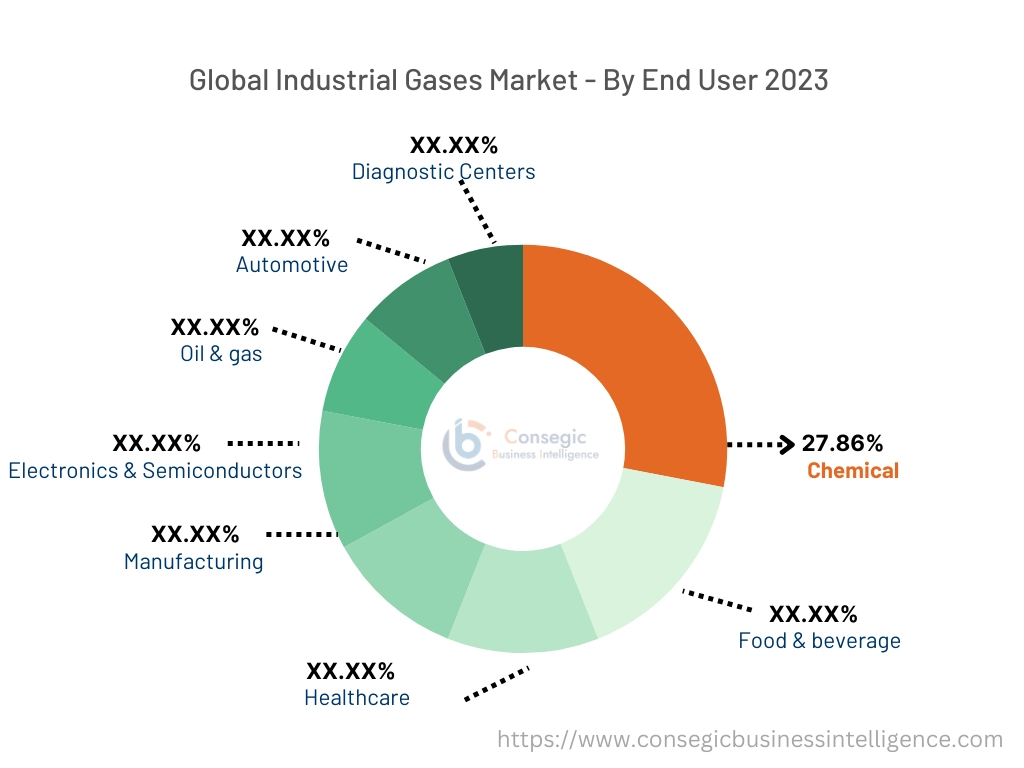
Regional Analysis:
The regions covered are North America, Europe, Asia Pacific, the Middle East and Africa, and Latin America.
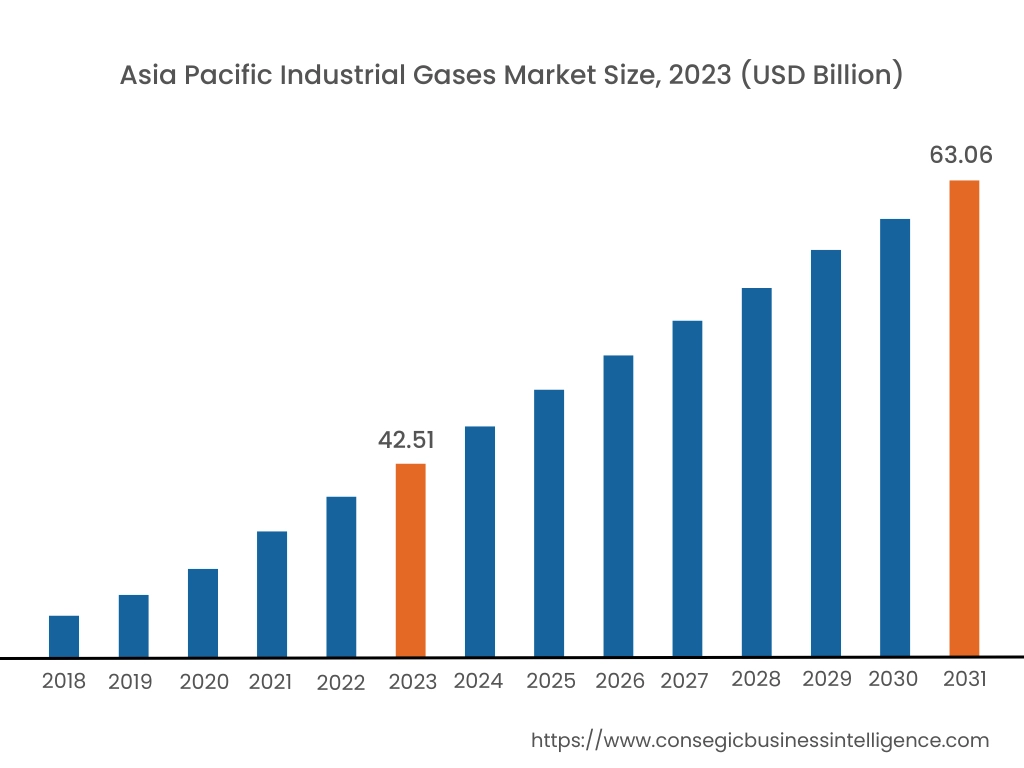
In 2023, Asia Pacific accounted for the highest market share at 40.75% and was valued at USD 42.51 Billion and is expected to reach USD 63.06 Billion in 2031. In Asia Pacific, China accounted for the highest share of 26.27% during the base year of 2023. Asia-Pacific market is driven by rapid industrialization and urbanization in countries like China, India, and South Korea. China's applications for the market are primarily fueled by its expanding steel, chemicals, and electronics industries. The country is also ramping up its use of hydrogen in energy applications as part of its transition to clean energy. India's growing pharmaceutical and food & beverage sectors are driving demand for medical gases and food-grade gases, respectively. In Japan, the focus is on advanced applications, including the use of these gases in fuel cells and semiconductor manufacturing.
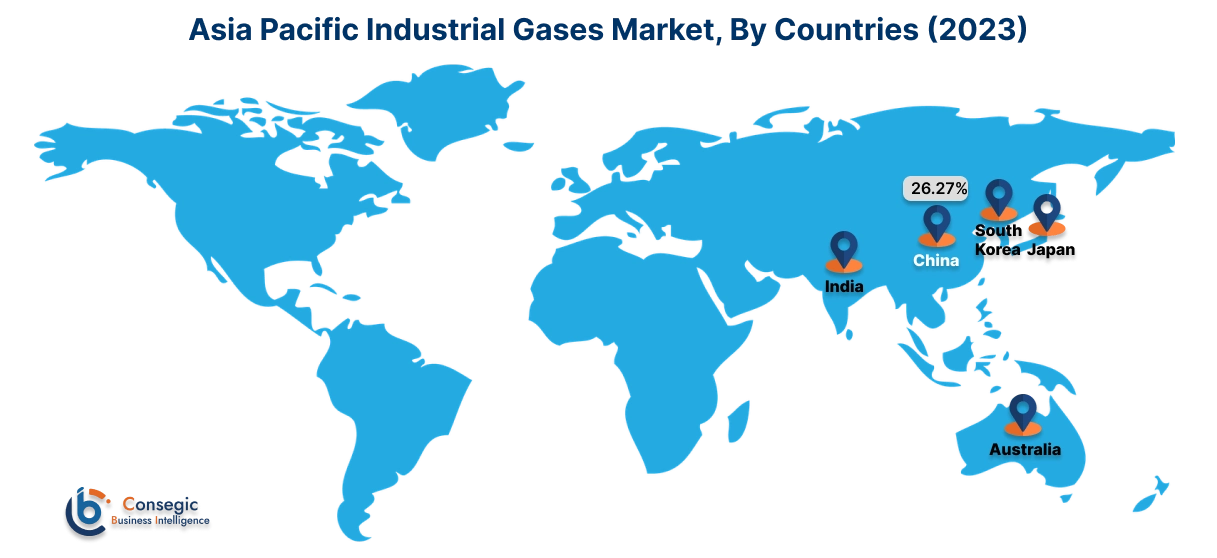
North America remains a key player in the industrial gases market, driven by strong demand from the manufacturing, food & beverage, and healthcare sectors. The U.S. leads the region, with significant utilization of gases such as oxygen and nitrogen in sectors like metal fabrication and chemical processing. The growing adoption of hydrogen for clean energy applications, particularly in California's hydrogen infrastructure for fuel cell vehicles, is also contributing to industrial gases market growth. In Canada, the demand for gases is rising in the oil and gas sector, especially for enhanced oil recovery techniques using carbon dioxide.
In Europe, the market is experiencing the fastest growth with a CAGR of 5.9% over the forecast period. The European market is supported by its strong automotive, chemical, and electronics industries. Germany, as a hub for automotive manufacturing, relies heavily on gases like argon and nitrogen for welding and metalworking processes. The UK's focus on reducing carbon emissions has accelerated the use of gases in carbon capture and storage (CCS) projects, which are becoming more prevalent. France and Italy are seeing increased use of specialty gases in the electronics sector, particularly for semiconductor production. However, the market faces challenges due to strict environmental regulations and rising energy costs, which affect the production and distribution of gases.
The Middle East & Africa region is experiencing steady growth, driven by the oil and gas, petrochemical, and construction sectors. The UAE and Saudi Arabia are increasing their investments in gas production to support large-scale petrochemical projects and infrastructure development. In Africa, South Africa is seeing rising demand for medical gases due to the increasing of healthcare services and the focus on improving hospital infrastructure. However, regional political instability and logistical challenges can hinder efficient distribution and supply chain management for industrial gases.
Latin America analysis shows an emerging market, with growth primarily driven by Brazil and Mexico. The region's food & beverage industry, especially in Brazil, is a major consumer of carbon dioxide for carbonation in beverages and food preservation. Mexico's automotive manufacturing sector heavily relies on gases like argon and nitrogen for welding and cutting applications. There is also increasing interest in the use of industrial gases for water treatment and air purification, driven by growing environmental awareness. However, the market faces challenges related to infrastructure limitations and economic fluctuations, affecting the consistent supply of these gases.
Top Key Players & Market Share Insights:
The industrial gases market is highly competitive with major players providing products and services to the national and international markets. Key players are adopting several strategies in research and development (R&D), product innovation, and end-user launches to hold a strong position in the global industrial gases market. Key players in the industrial gases industry include -
- Air Liquide (France)
- Linde plc (Ireland)
- Praxair, Inc. (USA)
- Air Products and Chemicals, Inc. (USA)
- Taiyo Nippon Sanso Corporation (Japan)
- Messer Group GmbH (Germany)
- Iwatani Corporation (Japan)
- Gulf Cryo (Kuwait)
- SIAD Group (Italy)
- Matheson Tri-Gas, Inc. (USA)
Recent Industry Developments :
In September 2024, Air Products (NYSE: APD) finalized the sale of its LNG process technology and equipment business to Honeywell for $1.81 billion in cash. This move aligns with Air Products' strategy to focus on core industrial gases and clean hydrogen. The sale includes assets, manufacturing capabilities, and about 475 employees, as well as a facility in Port Manatee, Florida.
Industrial Gases Market Report Insights :
| Report Attributes | Report Details |
| Study Timeline | 2018-2031 |
| Market Size in 2031 | USD 153.87 Billion |
| CAGR (2024-2031) | 5.1% |
| By Gas Type |
|
| By Production & Delivery Method |
|
| By Application |
|
| By End-User |
|
| By Region |
|
| Key Players |
|
| North America | U.S. Canada Mexico |
| Europe | U.K. Germany France Spain Italy Russia Benelux Rest of Europe |
| APAC | China South Korea Japan India Australia ASEAN Rest of Asia-Pacific |
| Middle East and Africa | GCC Turkey South Africa Rest of MEA |
| LATAM | Brazil Argentina Chile Rest of LATAM |
| Report Coverage |
|
Key Questions Answered in the Report
How big is the global industrial gases market? +
Industrial Gases Market size is estimated to reach over USD 153.87 Billion by 2031 from a value of USD 104.32 Billion in 2023, growing at a CAGR of 5.1% from 2024 to 2031.
What are the key drivers of the industrial gases market? +
Major drivers include rising demand in healthcare, food and beverage, energy, and manufacturing industries, along with advancements in clean energy solutions like hydrogen.
Which regions dominate the industrial gases market? +
The Asia-Pacific region leads the market, followed by North America and Europe, due to rapid industrialization and strong demand in emerging economies.
What are the primary applications of industrial gases? +
Industrial gases are used in industries such as healthcare (medical oxygen), manufacturing (welding gases), electronics (semiconductor production), and energy (hydrogen for clean fuel).
What are the major challenges in the industrial gases market? +
Challenges include high production and transportation costs, strict environmental regulations, and geopolitical risks affecting supply chains.
